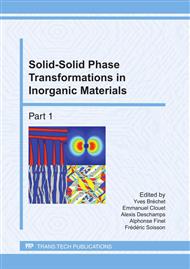p.624
p.633
p.640
p.646
p.652
p.658
p.664
p.670
p.676
Simulation of the β→α(O) Phase Transformation due to Oxygen Diffusion during High Temperature Oxidation of Zirconium Alloys
Abstract:
The EKINOX numerical code, formerly developed to simulate high temperature oxidation of Ni alloys, has been recently adapted to solve out the issue of high temperature oxidation of Zirconium alloys. This numerical code is a one dimensional model that simulates the growth of an oxide layer using a specific algorithm for moving boundaries problem. In order to simulate the oxygen diffusion inside Zr alloys, an adaptation of the EKINOX code was necessary. It consisted in adding, first, a non-null oxygen equilibrium concentration in the substrate and second, a new interface in order to simulate the β/α(O) phase transformation due to oxygen diffusion. In this study, EKINOX has also been coupled with the thermodynamic database for zirconium alloys ZIRCOBASE (thermocalc formalism) in order to obtain accurate concentrations values in each phases (considering local equilibrium at each interface). The present paper illustrates the simulation ability of the code by comparing experimental and calculated oxygen diffusion profiles corresponding to different cases, from isothermal oxidations at high temperature (900 < T < 1250°C) to the study of dissolution kinetics of a pre-transient oxide layer under a neutral environment. The influence of pre-hydriding from a few hundreds up to thousands weight-ppm is also derived from the calculations.
Info:
Periodical:
Pages:
652-657
Citation:
Online since:
June 2011
Keywords:
Price:
Сopyright:
© 2011 Trans Tech Publications Ltd. All Rights Reserved
Share:
Citation:


